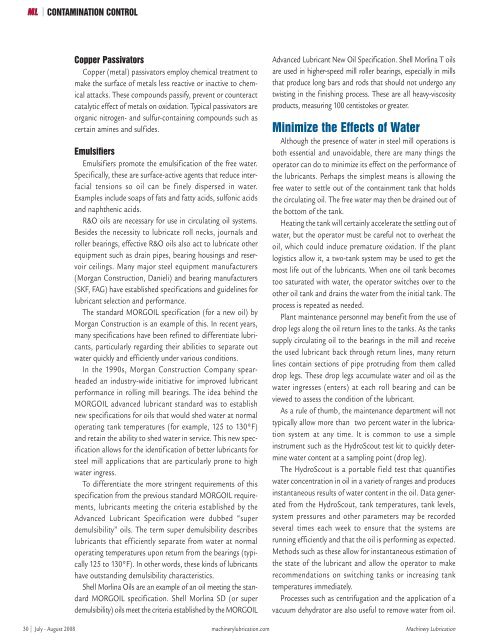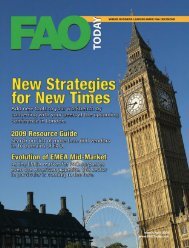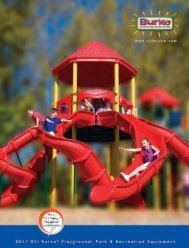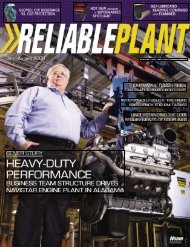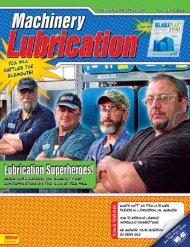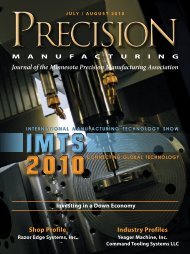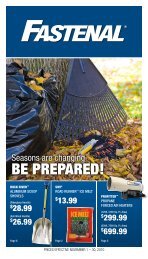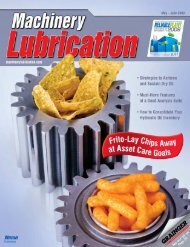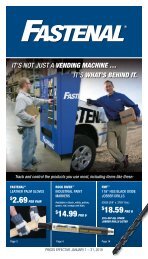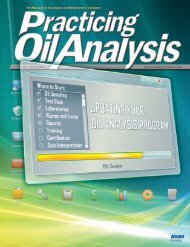Machinery Lubrication July August 2008
Machinery Lubrication July August 2008
Machinery Lubrication July August 2008
Create successful ePaper yourself
Turn your PDF publications into a flip-book with our unique Google optimized e-Paper software.
CONTAMINATION CONTROL<br />
Copper Passivators<br />
Copper (metal) passivators employ chemical treatment to<br />
make the surface of metals less reactive or inactive to chemical<br />
attacks. These compounds passify, prevent or counteract<br />
catalytic effect of metals on oxidation. Typical passivators are<br />
organic nitrogen- and sulfur-containing compounds such as<br />
certain amines and sulfides.<br />
Emulsifiers<br />
Emulsifiers promote the emulsification of the free water.<br />
Specifically, these are surface-active agents that reduce interfacial<br />
tensions so oil can be finely dispersed in water.<br />
Examples include soaps of fats and fatty acids, sulfonic acids<br />
and naphthenic acids.<br />
R&O oils are necessary for use in circulating oil systems.<br />
Besides the necessity to lubricate roll necks, journals and<br />
roller bearings, effective R&O oils also act to lubricate other<br />
equipment such as drain pipes, bearing housings and reservoir<br />
ceilings. Many major steel equipment manufacturers<br />
(Morgan Construction, Danieli) and bearing manufacturers<br />
(SKF, FAG) have established specifications and guidelines for<br />
lubricant selection and performance.<br />
The standard MORGOIL specification (for a new oil) by<br />
Morgan Construction is an example of this. In recent years,<br />
many specifications have been refined to differentiate lubricants,<br />
particularly regarding their abilities to separate out<br />
water quickly and efficiently under various conditions.<br />
In the 1990s, Morgan Construction Company spearheaded<br />
an industry-wide initiative for improved lubricant<br />
performance in rolling mill bearings. The idea behind the<br />
MORGOIL advanced lubricant standard was to establish<br />
new specifications for oils that would shed water at normal<br />
operating tank temperatures (for example, 125 to 130°F)<br />
and retain the ability to shed water in service. This new specification<br />
allows for the identification of better lubricants for<br />
steel mill applications that are particularly prone to high<br />
water ingress.<br />
To differentiate the more stringent requirements of this<br />
specification from the previous standard MORGOIL requirements,<br />
lubricants meeting the criteria established by the<br />
Advanced Lubricant Specification were dubbed “super<br />
demulsibility” oils. The term super demulsibility describes<br />
lubricants that efficiently separate from water at normal<br />
operating temperatures upon return from the bearings (typically<br />
125 to 130°F). In other words, these kinds of lubricants<br />
have outstanding demulsibility characteristics.<br />
Shell Morlina Oils are an example of an oil meeting the standard<br />
MORGOIL specification. Shell Morlina SD (or super<br />
demulsibility) oils meet the criteria established by the MORGOIL<br />
Advanced Lubricant New Oil Specification. Shell Morlina T oils<br />
are used in higher-speed mill roller bearings, especially in mills<br />
that produce long bars and rods that should not undergo any<br />
twisting in the finishing process. These are all heavy-viscosity<br />
products, measuring 100 centistokes or greater.<br />
Minimize the Effects of Water<br />
Although the presence of water in steel mill operations is<br />
both essential and unavoidable, there are many things the<br />
operator can do to minimize its effect on the performance of<br />
the lubricants. Perhaps the simplest means is allowing the<br />
free water to settle out of the containment tank that holds<br />
the circulating oil. The free water may then be drained out of<br />
the bottom of the tank.<br />
Heating the tank will certainly accelerate the settling out of<br />
water, but the operator must be careful not to overheat the<br />
oil, which could induce premature oxidation. If the plant<br />
logistics allow it, a two-tank system may be used to get the<br />
most life out of the lubricants. When one oil tank becomes<br />
too saturated with water, the operator switches over to the<br />
other oil tank and drains the water from the initial tank. The<br />
process is repeated as needed.<br />
Plant maintenance personnel may benefit from the use of<br />
drop legs along the oil return lines to the tanks. As the tanks<br />
supply circulating oil to the bearings in the mill and receive<br />
the used lubricant back through return lines, many return<br />
lines contain sections of pipe protruding from them called<br />
drop legs. These drop legs accumulate water and oil as the<br />
water ingresses (enters) at each roll bearing and can be<br />
viewed to assess the condition of the lubricant.<br />
As a rule of thumb, the maintenance department will not<br />
typically allow more than two percent water in the lubrication<br />
system at any time. It is common to use a simple<br />
instrument such as the HydroScout test kit to quickly determine<br />
water content at a sampling point (drop leg).<br />
The HydroScout is a portable field test that quantifies<br />
water concentration in oil in a variety of ranges and produces<br />
instantaneous results of water content in the oil. Data generated<br />
from the HydroScout, tank temperatures, tank levels,<br />
system pressures and other parameters may be recorded<br />
several times each week to ensure that the systems are<br />
running efficiently and that the oil is performing as expected.<br />
Methods such as these allow for instantaneous estimation of<br />
the state of the lubricant and allow the operator to make<br />
recommendations on switching tanks or increasing tank<br />
temperatures immediately.<br />
Processes such as centrifugation and the application of a<br />
vacuum dehydrator are also useful to remove water from oil.<br />
30 <strong>July</strong> - <strong>August</strong> <strong>2008</strong> machinerylubrication.com <strong>Machinery</strong> <strong>Lubrication</strong>


